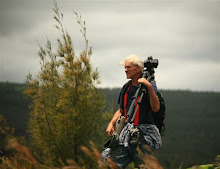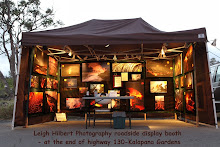 At sunrise, tour group lead by a local Kalapana Gardens resident takes in the sporadic surface lava breakouts. The Gardens and open ocean can be seen in the distance. The closest homes are still over 4000-ft away.
At sunrise, tour group lead by a local Kalapana Gardens resident takes in the sporadic surface lava breakouts. The Gardens and open ocean can be seen in the distance. The closest homes are still over 4000-ft away.  Above & below: Compared to where the lava was advancing to the east on February 15th, much of that eastern finger surface lava has stalled. There is, however, some new breakouts starting up just west of there this morning, and beginning to return to the brushy area it had previously passed along side of.
Above & below: Compared to where the lava was advancing to the east on February 15th, much of that eastern finger surface lava has stalled. There is, however, some new breakouts starting up just west of there this morning, and beginning to return to the brushy area it had previously passed along side of.
The surface lava continues moving south-southeast further below the kipuka seen burning in my last post.

But quite separate from these two flows is a third area much further south where molten lava is surging hotter and faster than the upper regions. The area I am talking about is very near the original July 2010 lava flow tube system and about 4000-ft southwest from the end of the road and maybe 2000-ft south from the above-mentioned kipuka… It’s hard to describe a spot in the middle of a vast uneven lavascape! … Anyway, I think this flow front may become the dominant one of the three. Perhaps reaching the ocean in the days ahead…

I think some of the older lava tubes that were feeding the east entry are being partially re-energized by the new lava coming down onto the coast now.
… Speaking of ocean lava, this morning at sunrise there was suddenly a burst of steam from the coast. This was located at the most recent lava site we refereed to as the east ocean entry.
 I hiked out there but by then there was only a small amount of steam and I could not spot any molten lava.
I hiked out there but by then there was only a small amount of steam and I could not spot any molten lava. On the way out to check that entry I came across more downed mango trees from when the lava came through a coastal kipuka forest last month.

Wild swings of magma pressure beneath Kilauea Volcano have been taking place this past week-- and the tiltemeters recorded a substantial drop in pressure in the past day:

USGS reports: Since Kilauea's summit vent first opened in Halemaumau Crater on March 19, 2008, it has grown from about 35 m (115 ft) to almost 150 m (490 ft) in diameter.
Check out this movie clip of a massive rockfall, the second of two on February 14th and there was another on the 15th.
Many other intresting movie clips and photos on this USGS Images page; including some spectacular new footage today of the lava rivers inside the Pu`u O`o crater--- things are really heating up in there these past few weeks! Click the highlighted text to open the links.
~~~~~~~~~~~~~~~~~~~~~~~~~~~~~~~~~~~~~~~~~~~~~~~~
I will try to post my next update in a few days unless some more exciting lava developments take place in the meantime ;)
You can always get onsite coastal lava flow information and viewing conditions by phoning Janguard lava viewing security management who are stationed along the access road at the end of Highway 130 from 2:00 PM until 10:00 PM daily: 430-1966










No comments:
Post a Comment